Duration: 1 – 2 hours
Not satisfied with the shape of your ears? Not to worry. Thanks to the new plastic and reconstructive surgery techniques, any ear deformity you are suffering from can be easily corrected. Whether you have protruded ears, Stahl’s ears, ear tags, cup ears or other conditions that are bothering you, we help you restore your confidence with a simple otoplasty surgery by the most experienced plastic surgeons in Iran.
All inclusive Otoplasty Packages in Iran
Otoplasty Prices
| Procedures | Price (USD) |
| Otoplasty refers to the surgical reshaping of the pinna, or outer ear. The aim may be to correct an irregularity or to improve appearance. |
$1450 |
| Otoplasty + Rhinoplasty refers to the surgical reshaping of the pinna, or outer ear. The aim may be to correct an irregularity or to improve appearance which can be done together with rhinoplasty. |
$3100 |
| Microtia Surgery (each step) – Grade 1 & 2 is designed to address both external ear deformity. By using a patient’s own tissue which is being done regularly in three steps. |
$3500 |
| Microtia Surgery (each step) – Grade 2 & 3 is designed to address both external ear deformity. By using Medpor implants which is being done regularly in more than one step. |
$4500 |
What We Offer
- Otoplasty
Clinic and doctor visits, medical tests, Otoplasty surgery in hospital, post-operative care, medicines*, recovery, and follow-up - T-Visa Authorization Code
T-visa authorization code. (Note that there is a separate visa fee that the patient must pay when receiving the visa, which it is not part of this package).
- Pick-up & Transfer
Airport pick-up, private transfer from hotel to clinic/hospital and vice versa - Accommodations
6 to 7 nights stay in a three-star to five-star hotel offered which is preferably near the clinic or hospital (At the patient's expense) - Other Services
24-hour on-call assistance, interpreter, SIM card and internet
Note :
* The medicines and other aftercare items included in this package are the necessary items prescribed by the surgeon.
Also, the doctors and hotels and clinics which are included in the package are offered by AriaMedTour to the patient. There may be other doctors whom the patients considered and the price might be different.
It is highly recommended to bring a companion with you for this surgery as it will facilitate your stay and recovery after the surgery.
In Microtia surgery cases the duration of stay is probably more than 7 days. Based on a new policy of the Ministry of Foreign Affairs, the citizens of the USA, UK, and Canada are included in different logistic services.
* Cancellation and Refund Policy
A deposit is an advance payment to secure a spot by the user after making an informed decision and agreeing to receive a service and cannot be refunded due to the user’s refusal to receive the service or cancellation for personal reasons.
In the event of a cancellation by the patient after arrival in Iran, the following amounts will be deducted from the total payment, and the remaining balance will be refunded:
- Cancellation before the initial consultation with the surgeon: 15% of the total payment, plus incurred expenses will be deducted.
- Cancellation after the initial consultation but before hospital admission: 40% of the total payment, plus incurred expenses will be deducted.
- Cancellation after hospital admission and preparation for surgery: No refund will be issued.
Please note: If the cancellation is due to a newly diagnosed acute illness or emergency medical condition that was not disclosed by the patient on the pre-travel checklist, refunds will not be provided.
Hear about our patients’ experiences in Iran: They have so much to share.
Watch these stories from different patients around the world to see why people choose Iran for their cosmetic surgeries and how AriaMedTour facilitates their medical trip to Iran.
A medical trip documentary:
Crossing borders for a unique beauty adventure
Having Experienced a Failed Plastic Surgery,
Pakistani Girl Chooses Iran for a Perfect Revision
Beauty Redefined: A Cosmetic Surgery
Journey to Iran – AriaMedTour Documentary
A Smooth Medical Trip to Iran
for an Amazing Transformation
Swiss Patient Trusts Iran for
His Cosmetic Surgery Among All Destinations
Australian Lady Saves Money Having
Successful Plastic Surgeries in Iran
Croatian Girl’s Careful Research Led Her
to Iran for an Amazing Plastic Surgery
A Medical Trip to Iran Is Worth It as You Enjoy
Both Great Surgery Results and Low Prices
Before & After Photos
Take a look at ‘before and after’ photos of people who got their ear surgery done in Iran.
Your detailed schedule after arrival in Iran
>> Day 1: Arrival at airport: you will be welcomed by our guide, then picked up and transferred to hotel*. Checking into hotel; Transfer from hotel to clinic; Visiting the doctor; Pre-op tests; Transfer from clinic to hotel
>> Day 2: Transfer from hotel to hospital; preparations for surgery; conversation between doctor & patient, reviewing the expectations; Performing of surgery; Post-op recovery at hospital; taking doctor’s instructions
>> Day 3: Taking doctor's instruction; Transfer from hospital to hotel; Rest in hotel; taking post-op medications; following instructed diet; follow-up through doctor’s assistant.
>> Day 4: RRest in hotel; regular eating restarts; daily walking; taking post-up medications
>> Day 5: Rest in hotel; Regular eating restarts; Daily walking; follow-up through doctor's assistant
>> Day 6: Taking shower at hotel; transfer from hotel to clinic; check-up and bandage removal (by the doctor)**; reviewing post-op instructions and dos & don’ts; receiving written certificate from doctor confirming patient is fit to fly; transfer from clinic to hotel.
>> Day 7: Transfer from hotel to AriaMedTour’s office; AriaMedTour gives patient special gift***; start of permanent follow-up through communication channels.
>> Note:
* Transfer from the airport to the hotel will be with the taxi.
** The doctor visit may be in the 7th or 8th day depending on the circumstances.
*** In some cases where your departure is in the weekends this step may not be feasible.
About our hotels
We work with a select group of three- to five-star hotels in Tehran and other cities. Depending on the type of package you choose and the location of the hospital or clinic where you are going to receive the treatment, we arrange the most suitable hotel for you. The name, details, and photos of the hotel will be sent to you ahead of time.
Otoplasty in Iran: All you need to know
Otoplasty or cosmetic ear surgery is a plastic surgery intended for correcting the deformities of the ears. Otoplasty is offered at Iranian cosmetic clinics and hospitals at very affordable prices. There are a host of highly-skilled Iranian plastic surgeons performing otoplasty in Iran, who specialize in plastic surgery, including ear reconstruction surgery and ear pinning.
Otoplasty cost in Iran
Just like any other plastic surgery, the price of cosmetic ear reshaping surgery in Iran is much more affordable than many other countries. Depending on the type of surgery, doctor, and clinic, an otoplasty surgery costs between $1200 and $2000 in Iran (Please note that this is simply a price range for ear surgery in Iran. Our prices are usually somewhere near or above the average of this range given our quality of services and the expertise of our surgeons).
At AriaMedTour, we offer all-inclusive ear surgery packages that come with all medical tourism services (visa, hotel, transfer, etc.) at various prices to fit all budgets. The prices we offer for otoplasty in Iran are transparent and cover all expenses, including anesthesia and medications, things that usually have separate costs in other countries.
Haven’t decided yet? Let us help you, it’s free
Otoplasty surgeons in Iran
Iranian otoplasty surgeons we work with are well-trained and experienced, who have performed hundreds of ear reconstruction surgeries during their prolific career, spanning more than 10 years. Our plastic surgeons offering cosmetic ear surgery in Iran are plastic surgery or ENT specialists who have passed advanced fellowships and specialized courses in plastic and reconstructive surgery.
What is otoplasty surgery and what does it fix?
Otoplasty is any type of ear correction surgery aimed at improving the appearance of the ears by altering the shape, proportion, and position of them. Ear reshaping surgery is sought by people who are unhappy with their congenital or acquired ear deformity, including those with prominent ears (protruding ears), Stahl’s ears, cup ears (also called lop ears and constricted ears), ear tags (also known as accessory tragus or branchial cleft remnants), and ear defects caused by an injury or accident.
Types of otoplasty
There are different types of ear correction surgery: ear pinning, ear augmentation, and ear reduction.
Ear pinning
Technically called otopexy, ear pinning (sometimes referred to as ear pinback) is a common ear reshaping surgery for flattening protruding ears. Ear pinning surgery is commonly carried out for children, but adults, too, can undergo this procedure if they feel dissatisfied with their appearance.
Ear augmentation
Ear augmentation surgery is aimed at enlarging or reconstructing the ears in people who suffer from a condition called ‘microtia’, in which the external part of the ear (pinna) is underdeveloped or non-existent. There are three approaches to ear reconstruction surgery: Rib Cartilage Graft Reconstruction, polyethylene plastic implants (Medpor), and ear prosthesis.
Ear reduction
Sometimes the pinna of the ear is larger than normal. This congenital deformity is technically referred to as ‘macrotia’. Ear reduction surgery is intended to reduce the size of too large ears by removing a portion of the cartilage and skin.
How is otoplasty performed?
Cosmetic ear surgery can be done by a plastic surgeon or an otolaryngologist. It is performed either under local or general anesthesia, depending on the age of the patient and other factors. An otoplasty procedure takes between 2-4 hours.
The surgeon makes incisions to the ears, and depending on the problem, alters the cartilage of the ear. He/she can reduce the size of the ear and pin it back to prevent them from sticking out, reshape the cartilage, or reconstruct it in cases with microtia.
As said earlier, there are three methods for ear reconstruction surgery. The first technique involves taking a piece of the patient’s own rib cartilage and sculpting it into the form of an ear. This procedure is usually done at the age of 8 when the child’s rib cage is large enough to provide the donor tissue, but some of the more experienced surgeons may do this surgery on a 6-year-old child.
If the polyethylene plastic implant method is employed for ear reconstruction, it can be performed on a child at the age of three. MEDPOR ear reconstruction is a one- or two-stage procedure involving placing a porous polyethylene implant on the underdeveloped ear, allowing the patient’s tissue to grow into the material. 3 to 6 months after the surgery, a second appointment may be required for minor adjustments.
Ear reconstruction with ear prostheses is another technique in which an ear-shaped prosthesis is attached to the missed or underdeveloped ear using adhesive or titanium screws with the aim of improving the appearance. Ear prostheses are colored in a way to match the color of the surrounding skin so that they look as they are real ears.
What should I do before ear correction surgery?
There are some general guidelines that should be followed before an otoplasty procedure, which are as follows:
- Do not use any medications containing Acetylsalicylic acid (such as Aspirin), as they might increase bleeding during and after surgery.
- Attend a pre-operative consultation appointment to discuss different issues regarding the surgery, including expected results and potential complications.
- Make sure that you have not suffered from any viral illness at least three weeks before the surgery. If so, inform your surgeon.
- Wash your hair the day before the operation, and do not wear any makeup or earrings on the day of the surgery.
Otoplasty recovery and post-op instructions
After the completion of an ear reshaping surgery, the surgeon applies soft dressing on the surgical site, which should be kept in place for one week. The surgeon may also prescribe a soft, flexible headband for two weeks after surgery, which helps hold the ears in the right position.
The bandage should be replaced the next day after the surgery, and then again after 2 days. The bandage is completely removed after 7 days. You can wash your head after the bandage removal and wear the protective band over your ears for a one more week or two.
There might be some mild discomfort or sleep disruptions for a few days after surgery. Make sure to ask your doctor to prescribe the right pain medications if you need to take some. Do not self-prescribe anti-inflammatory pain drugs because they can slow healing and cause bleeding.
Be sure to protect your ears from cold, and in order to prevent any infections, avoid swimming during your recovery period. Sports and physical activities can be resumed after approximately 5 weeks. You can return to work in a few days.
Otoplasty risks and complications
As with any surgery, there are some risks in otoplasty, but they are minor and rare. Scarring is a side effect of ear correction surgery, which in most cases is barely visible because it is located behind the ear.
Bleeding and infection are other potential complications of otoplasty, which rarely occurs if you take good care of yourself. Mild or moderate pain is common after surgery, which can be relieved by taking pain-killing medications.
Be sure to contact your doctor or seek medical attention in case you experience fever and excessive bleeding and swelling, or you have any trauma to your surgical site.
Frequently Asked Questions About Otoplasty
Am I a candidate for otoplasty?
If you feel self-conscious about your protruding ears or have other ear deformities that are causing you to feel embarrassed in social situations, otoplasty can help you regain your self-confidence. Although ear reshaping procedures are commonly done in children, men and women well into their 40s or 50s can also consider undergoing otoplasty to improve their appearance. Ear corrections surgery candidates should also have good overall health and realistic expectations.
How much does ear reshaping surgery cost?
It depends on many factors, such as the country where the surgery is done, the doctor’s reputation and experience, type of surgery, etc. For a price quote for otoplasty in Iran with AriaMedTour, feel free to contact us.
Does ear reshaping surgery leave scars?
Scars after surgery are hardly noticeable because they are well hidden behind the ears.
Is ear reshaping surgery painful?
Cosmetic ear surgery doesn’t hurt while is being performed because either local anesthesia is applied, which numbs the surgical area, or general anesthesia is used, which puts you to sleep.
Is otoplasty safe?
As long as it is done by a qualified surgeon and you follow post-op instructions, ear correction surgery is one of the safest procedures.
Contact Our Medical Support Team:
Feel free to express your opinions or ask your questions

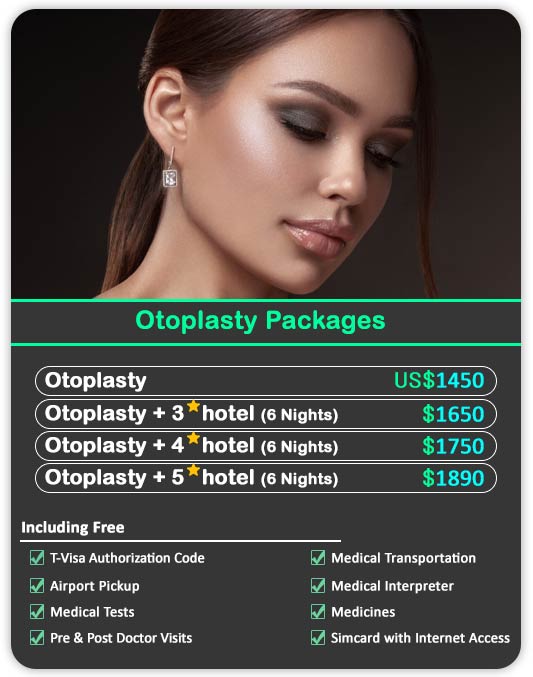

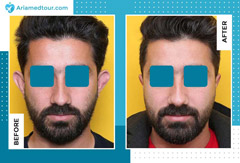

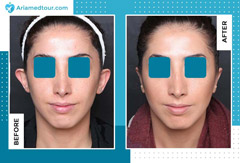
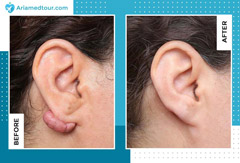

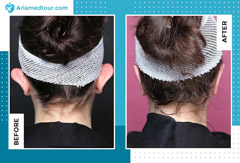
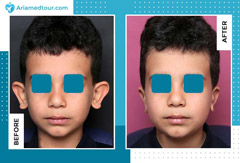

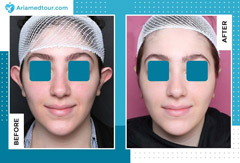

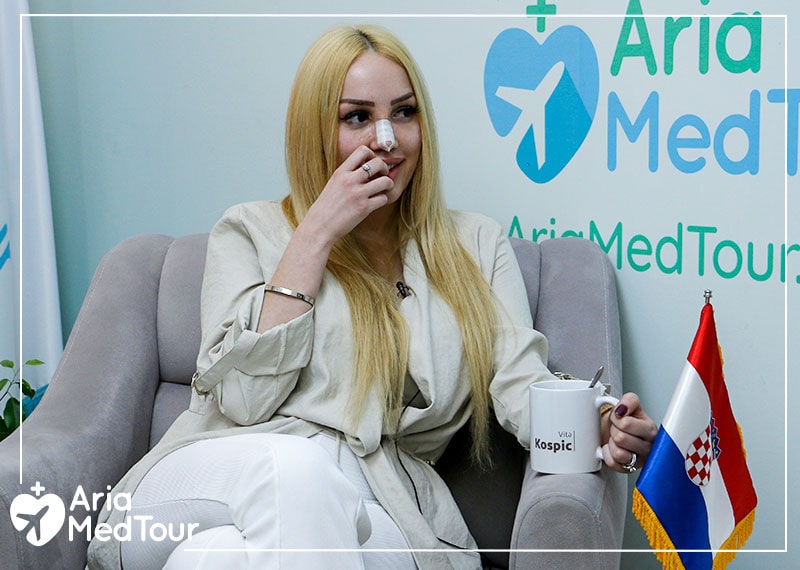



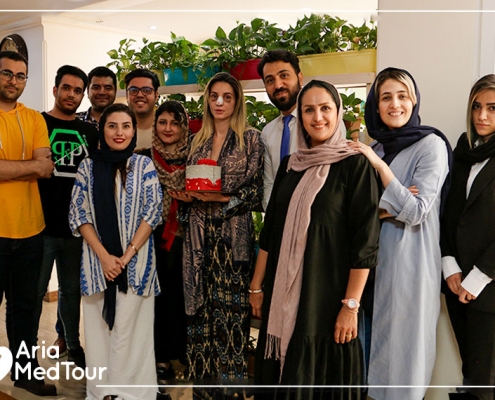



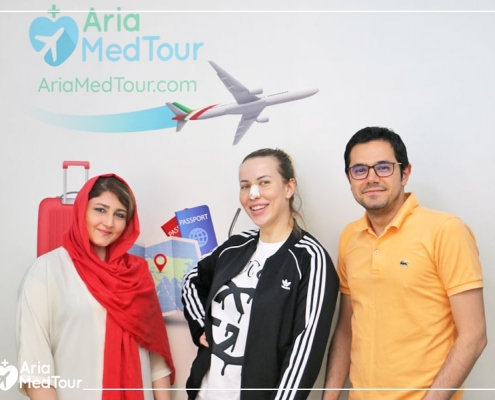
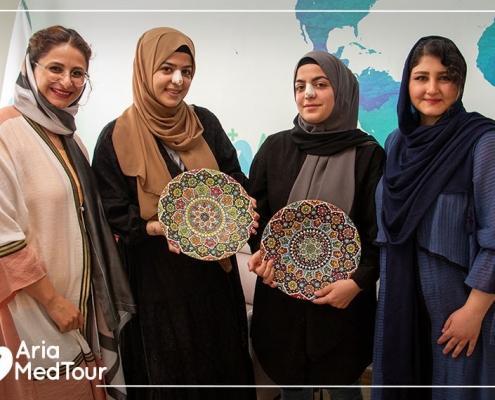
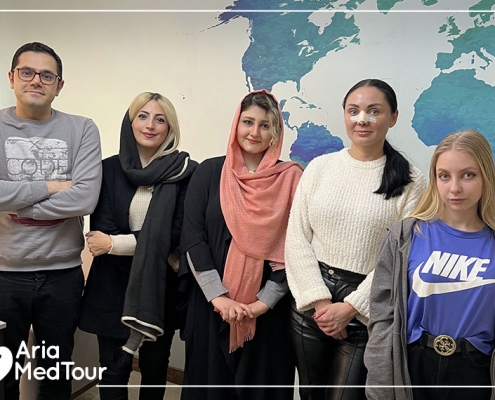
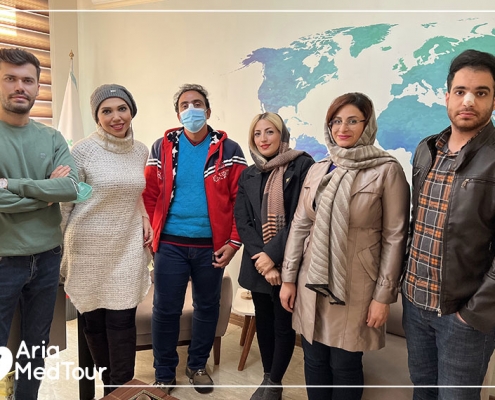

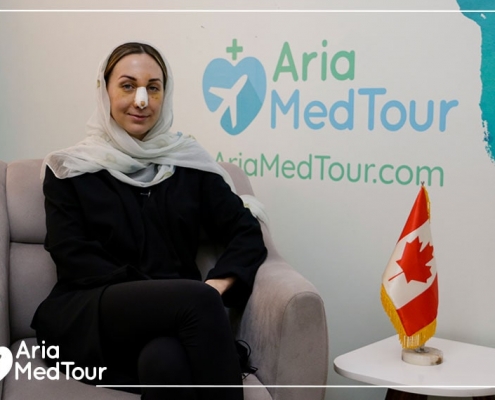
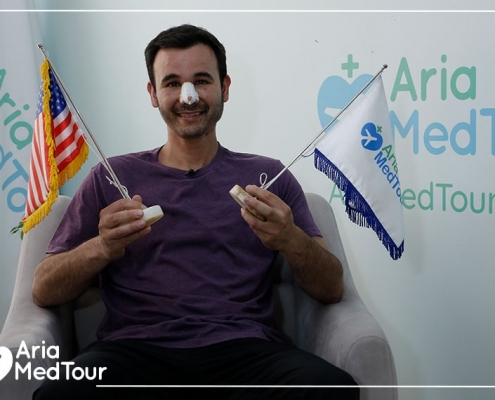












I’ve had a cauliflower ear for years and want to correct it. I used to think it would go away on its own a while after my ear was injured, but apparently, it won’t. Is there a real non-surgical or surgical treatment for them?
Cauliflower ears result from a direct injury to the outer ear when the blood supply to the cartilage is blocked and the overgrowth of ear cartilage leads to a lumpy appearance, looking like cauliflower.
Cauliflower ears won’t resolve on their own and require immediate medical treatment, or else they turn into a permanent condition (in 7 to 10 days) and there won’t be a non-surgical solution to fix them afterward. The appearance can be improved through otoplasty surgery but the risk of recurrence is high as the body reacts to the cartilage shaving performed during the surgery just like another injury. So, it is important both during and after the surgery to prevent blood accumulation between the cartilage and the skin. It can be achieved through precise sutures to properly close the dead area and applying pressure dressing after the surgery.
I am 24, female, and am looking for a non-surgical solution for my protruding ears or some way to make them grow closer to the head. Please help.
As an adult in your twenties, your ear cartilage is not gonna keep growing so there won’t be a method to train them to grow flatter. Unfortunately, there is not a non-surgical solution for prominent ears at this age either. Ear molding, as a non-surgical method, can be used only for infants of a few weeks to correct this deformity when the cartilage is still flexible and soft. However, ear surgery to correct protruding ears, also known as setback otoplasty, is an outpatient and relatively simple procedure and can be done as early as the age of 5-6. Setback otoplasty is usually done under local anesthesia for adults and general anesthesia for children. It includes incisions behind the ears to reshape the cartilage and pull them closer to the head while leaving well-hidden, unnoticeable scars. Sometimes additional sutures on the back of the conchal may be required to help the whole ear sit closer to the side of the head more effectively. You’ll be discharged from the hospital on the same day with a dressing to support keeping the ears in their new place. You will be required to use the ear dressing for about 1-2 weeks.
I have uneven ears, the right one seems fine and the left is protruding, more than the other. Could it get fixed and if I’m fine with the shape and position of the right ear could it be done on one ear only?
Thanks for your question. Yes, protruding ears can be fixed through setback otoplasty and the procedure is quite straightforward. Unilateral correction is also common when it comes to fixing asymmetries through ear surgery. However, not all cases could reach a desirable result if the surgery is performed only on one ear. Some require bilateral manipulation to achieve a more optimal post-op symmetry. Therefore, you need to discuss it with your surgeon through an in-person visit. Depending on the case, your surgeon may need your permission to do some fine adjustments on your left ear as well to bring perfect symmetry.
A part of my ear above the lobe has a pointy protruding cartilage which makes my ear kind of weird and angular instead of being soft and round. Is it treatable?
Thank you for your question. While it is difficult to give definite answers without seeing your photos, I guess what you’re describing is a form of Darwinian tubercle on one ear that is pretty common and could be simply treated through a quick in-office surgery under local anesthesia to shave the extra piece of the cartilage. If you could send a high-quality photo of your ear, I’d be able to give you a more precise answer though.
I’ve got large protruding ears which are really embarrassing especially when I hold my hair up or try a ponytail. In fact, I always try to hide them under my hair as much as possible but sometimes they’re exposed and I feel terribly insecure. I think they badly need to get smaller, not just flatter. Is there a way to make them smaller? I’ve been searching for a while but all I find is about protruding ears.
Good question. Yes, it is possible to ACTUALLY reduce the size of ears but the procedure is a bit more complicated than a traditional otoplasty which is quite common and straightforward. This is probably why all the results you find come down to this surgery for treating prominent ears. Actually, the majority of people get the desired result with this treatment since pulling ears closer to the head creates the illusion of smaller ears and makes them much unnoticeable even if they’re really larger than normal. So most surgeons don’t recommend undergoing a reduction surgery due to the potential scarring and deformity. However, people have different preferences and you may find the pros of the surgery outweighing its cons. An in-person examination and consultation with a trusted board-certified surgeon can help you decide which procedure benefits you more based on your condition.